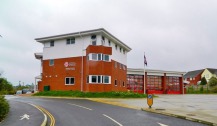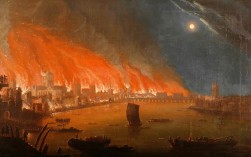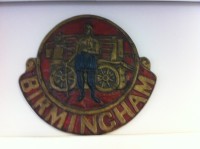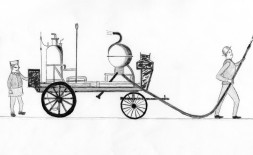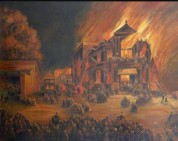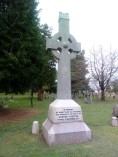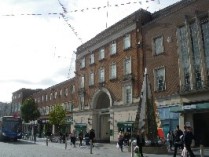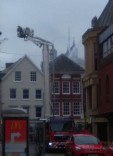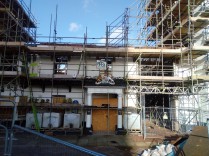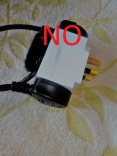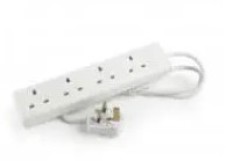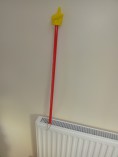
Wednesday 17 January 2018 Visit
- In 1003 the Vikings burnt Exeter to the ground – even St Peter’s, not yet a cathedral - and hundreds perished. Why ? Could this have been prevented ?
- In 1886 Exeter’s Theatre Royal was destroyed by fire and 187 died. What caused this fire and why did so many people die ? Could their deaths have been prevented?
- Last year we lost the Clarence Hotel. This time no one died – why ? But could the devastation have been prevented ?
HISTORY OF EXETER’S FIRES
A few hundred years later, William the Conq threatened to destroy Exeter when we refused to pay his taxes. But Exeter people aren’t stupid; they gave and the city was saved. No conflagration there.
The Great Fire in London started in the night in 1666. It spread quickly. it was windy, which blew burning embers around the still-sleeping city and a huge wooden waterwheel supplying Thames water to the city caught fire so the available water was seriously reduced. Guys with buckets didn't stand a chance.
The fire raged for days. Eventually the Royal Navy cleared nearby land by pulling down buildings and using gunpowder where necessary.
This fire break succeeded and after five days the Great Fire of London finally died. This event also marked the end of the city’s plagues –because so many rats were destroyed ?
After the Great Fire, new laws required that each quarter of the city must provide 800 leather buckets and 50 ladders and each house must have buckets with the occupants required to participate in hand-to-hand bucket brigades. Exeter followed suit.
Within a year, the first fire insurance company was established with fire-fighting teams and identifying badges. Exeter soon followed - and Birmingham, as can be seen from this example on the left. These brigades were not there for the protection of the general public. The insurance companies only issued identifying tin plaques to their policyholders. Often fire brigades would rush to a fire but if it didn’t have the correct plaque on the wall they'd either leave or, more likely, stay to watch but not help. So … no plaque ? End of building.
The very first horse-drawn steam fire engine (right) was built in 1829 by John Braithwaite, a colleague of George Stephenson. Water was drawn into the pump on the right on the right of the trailer. This was powered by steam produced by the boiler on the left. The uncoupled shafts for the horses can be seen on the right of the tralier.
Gradually these spread throughout the land – even in Exeter - and as they were horse drawn they considerably improved the response time to incidents.
In 1887 came the Theatre Royal fire in London Inn Square on the corner of Longbrook Street. This building had ultra-modern gas lighting which ignited some back stage fabric and the fire spread through the auditorium.
The theatre had been built with shops down one side but of course they had all closed for the night and all the side exits were locked.
There was panic as 800 people crowded to the few exits at the back of the building. 186 lost their lives, some having been crushed to death in the crowd.
The West of England Insurance Company’s fire brigade was based only yards away yet, even with help from the general public and particularly the landlord of the New London Inn who brought ladders and gave shelter to the victims in his inn, massive losses were unavoidable. The dead were laid out in the pub’s stables.
One benefit from this dreadful fire was a new law demanding that Safety Curtains be installed and seen to operate in theatres country wide. It’s ironic that our own Northcott Theatre doesn’t, however, display a safety curtain because it is too small for it to be considered necessary – the theatre seats fewer than 500.
Another very important result of the fire was that in 1888 Exeter City set up the Exeter Municipal Fire Brigade which took over the various fire insurance companies’ equipment and re-hired the firefighters. Their job was to fight fire, whether the building was insured or not.
Another horrendous fire was the Victoria Hall in Queen Street. Built to accommodate 2,000 people, it caught fire in 1919 in the night. The Fire Brigade Office sent five vehicles but they just weren't enough to save the building.
In 1942 the horrific damage wreaked on Exeter during the Second World War was mainly due to fire bombs. So much of Exeter city was built of timber and so much of it was destroyed - not all the fire brigades in the world could have saved it. Various brave-to-the-point-of-foolish people climbed to the top of valued buildings to throw bombs off the roofs before they ignited! Three firebombs on the Guildhall were thrown off by such brave individuals.
“EXETER WAS A JEWEL AND WE HAVE DES-TROYED IT” boasted German radio. They had.
But after the war, Exeter was re-built and the Council exercised tight controls. Those High Street buildings stand today, looking somewhat 1930s-inspired although the Council’s brief was that they should be neo-Georgian. And all pretty fire-safe !
Our own Chairman, Colin, tells of a fire in Tremlett’s Tannery when the only part of the building to survive was his father’s office. Colin, then a small(ish) boy, was taken down there the day after the fire and can remember being able to see various landmarks previously hidden by the factory building.
Except of course for the Clarence just over a year ago. It seemed that every single person watching that day had a connection with that hotel – perhaps a tea as a reward for passing Grade I music … or for getting good grades in GSE or GCSE, or for marriage proposals, all manner of celebrations. The hotel was deeply rooted in the souls of everyone and its passing was a great sadness.
There were up to 200 fire fighters at any one time, backed up by 38 fire engines and 57 support vehicles ! These came from all over Devon, from places as far away as Princetown, and from surrounding counties.
We were all amazed and gratified at the efforts of the Fire Brigade to contain the flames and somewhat horrified to observe the bravery of the officers, particularly those way up in the sky desperately pouring water onto the fire from cherry pickers. We are all united in our gratitude that the medieval shops backing on to the hotel were saved (thanks are here due to Dr Todd Gray for drawing the brigade’s attention to their importance).
That no one died in that fire is a miracle. Surely the night porter should be decorated, for it was he who made sure that everyone sleeping in the hotel was woken and forced to leave – still in their nightwear. His powers of persuasion must have been immense – none of us would welcome wandering the November streets in our jimjams. One enterprising couple, having grabbed their keys as they left, just, I understand, got into their car and drove straight home. Certainly the best solution ! Considering their attire, we trust they didn’t need to stop for coffee at a service station …
The fire spread along three buildings through the attics. Way back in the late 1800s a report was published recommending that the attics of adjoining buildings should be separated with non-flammable materials. This report was ignored so the Clarence fire was really just waiting to happen. So tragic that this electrical failure in an empty building was not contained and was able to spread through the roof spaces to the hotel.
The fire spread along three buildings through the attics. Way back in the late 1800s a report was published recommending that the attics of adjoining buildings should be separated with non-flammable materials. This report was ignored so the Clarence fire was really just waiting to happen. So tragic that this electrical failure in an empty building was not contained and was able to spread through the roof spaces to the hotel.
The firemen had problems locating the fires. They could see the smoke, smell the burning but had to search for the source. One fireman nearly died. Spraying a cavity between the hotel and the Well House the floor gave way and in that second his partner managed to grab him and save him from falling into the fire.
We are all eternally grateful to the courage and guts of our fire officers. And at this point just such a one, Gareth, took over the floor to give us advice on preventing fires in the modern age.
First Gareth showed us a 3-way electrical adaptor (though these are difficult to obtain these days) and asked us if we still used them. He highlighted that a 13amp adaptor would be overloaded if too many appliances were used through it, and would heat up and eventually catch fire. It was important to be reminded of this potential hazard.
Similarly the modern multi plug adapters (such as 4-gang trailing extension leads) cannot cope with high energy plugs – usually the ones that produce heat i.e. kettles, toasters, hairdryers etc.
They are fine, he explained, for lower use appliances so long as the total output does not exceed 13 amps (4 kilowatts). They are much safer than an adaptor because the plug to which the sockets are connected will have a 13amp fuse. This, hopefully, will blow before catching fire!
Gareth then moved from fire prevention to fire warnings and was very keen that we should all have smoke alarms.
There should be at least one on each floor and in the centre of ceilings in much used rooms (not actually in the kitchen as it would go off unnecessarily). Even 10-year fire alarms should be checked regularly and all others should be checked weekly. Batteries wear out (or perhaps someone borrowed one and forgot to replace it?). Checking detectors needs to be built in to people’s routines e.g. every Friday evening check all the alarms. And we were given this delightful stick with yellow hand to help us reach the ceiling.
We should all think about a night time routine, turning off electrical appliances that are not needed. And we should shut all doors before retiring for the night. This delays smoke from spreading through the home and the smoke alarms will wake us before the danger is too great. Feel a door before opening it. If it’s hot leave it shut. Block duvets along the bottom of the door, open the windows and shout. Call 999. Obviously climb out if it’s safe – a shed roof below a window perhaps. Otherwise stay in the room and inform 999 which room you are in so that rescue is not delayed.
We then trouped down to examine those massive great red engines. We saw the gleaming firemen’s pole (still used as quicker and safer than stairs) and the print-out machine in the same room (19th & 21st century technology side by side!). This machine gives all the details of the emergency for the fire fighters to read as they arrive from the pole and are donning their boots and overgarments.
Then we saw the engines and were given full descriptions of all the equipment they carried and what it was for – breathing equipment, water safety, etc. Some of us sat in the cabs – a long way from the running boards of old. Sadly, the shortage of available fire fighters (due to an emergency which had called them away earlier in the morning) we could not be treated to an exhibition of the drills and practices the staff undergo – carrying each other down ladders etc!
But it was nevertheless a terrific morning and we left determined to follow Gareth’s strictures on safety in the home and with greatly increased respect for the men who daily risk their lives to save ours.
